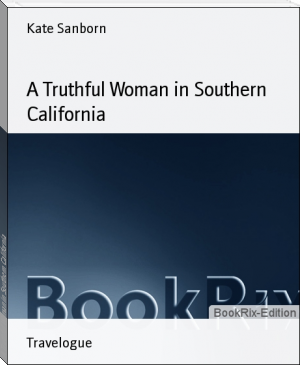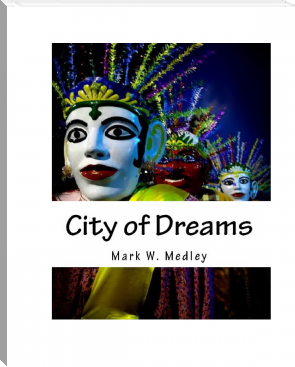A Truthful Woman in Southern California, Kate Sanborn [best thriller novels of all time .txt] 📗

- Author: Kate Sanborn
Book online «A Truthful Woman in Southern California, Kate Sanborn [best thriller novels of all time .txt] 📗». Author Kate Sanborn
the Lord had made him and then pinched him." One does not see the orange groves here, but the lemon trees and walnuts and olives are an agreeable change - just for a change.
"Who ever thinks of connecting such a commonplace article of diet as the lemon with the romantic history of ill-fated Anne Boleyn? Yet, indirectly, she was the cause of its first introduction into England, and so into popular notice. Henry VIII., who, if he rid himself of his wives like a brute, certainly won them like a prince, gave such splendid feasts and pageants in honor of the coronation of Anne and of their previous nuptials as had seldom been accorded to queens of the royal blood. These kingly entertainments were in turn followed by the great civic feast of London, for which the whole world was searched for delicacies to add to the splendor. At one such banquet, graced by the presence of the royal pair, a lemon was introduced as an elegant novelty. To an epicure such as Henry, the acquisition of a castle in France would have proved less acceptable, and such was the importance attached to the discovery - so says an old biographer - that a special record was made of the fact that the cost of this precious lemon was six silver pennies."
We hear nothing of irrigation, but almost everything will thrive without it. The soil grows well all varieties of fruits found in the Eastern and New England States, besides all the semi-tropical fruits, as guavas, loquats, persimmons, dates, etc. As the Rev. Mr. Jackson says: "Could it be shown that the primitive Eden bore as many fruits pleasant to the taste, it would add a new pang to the thought of original sin."
The number of native trees seems small, but trees have been naturalized here from every part of the world. The pepper tree is from Peru, also the quinine tree: from Chili, the monkey tree and the Norfolk Island pine.
Mr. Cooper imported the eucalyptus from Australia. It grows rapidly, and is planted for windbreaks. It is used for firewood, and when cut down nearly to the ground will start up with the same old courage and ambition. Its roots are so eager for water that they make long detours, sometimes even climbing up and down a stone wall, if it is in their route, or into a well. From the same country comes the acacia, the rubber tree, and a large number of shrubs. New Zealand contributes her share, and to China and Japan they are indebted for the camphor tree, the gingko, the loquat, and the chestnuts. To South Africa they are indebted for the silver tree, and from the northern part of that country the date-palm and the tamarind.
One sees side by side here, and in Pasadena, trees from almost opposite climes: the New England elm and a cork tree, a cedar of Lebanon and a maple or an English oak. Then the glorious palm - twenty-two varieties in Montecito Valley alone.
Sydney Smith said of the fertility of Australia, "Tickle her with a hoe and she laughs with a harvest." But in California even the hoe is not needed, for "volunteer crops" come up all by themselves, and look better than ours so carefully cultivated. They say that if a Chinaman eats a watermelon under a tree the result is a fine crop of melons next year. And I read of a volunteer tomato plant ploughed down twice that measured twelve feet square, and bore thousands of small red tomatoes.
Alfalfa is an ever-growing crop - can be garnered five times each year.
And as for flowers, I really cannot attempt to enumerate or describe in detail. There are hundreds of varieties of roses. They were found growing wild by myriads, and have been most carefully cultivated and improved. One rose tree in the grounds of the Arlington Hotel has spread over sixty feet of the veranda, and three lady guests have climbed into its branches at once. As one man said: "The roses here would climb to the moon if a trellis could be provided."
A friend sent me twenty-five large bunches of the choicest roses from her garden one morning in April, each bunch a different variety. Their roses are shipped in large quantities to San Francisco, and Chicago has her churches decorated at Easter from the rose gardens of Santa Barbara.
Honey naturally is thought of. Apiculture here is a great business. The bee has to be busy all day long and all through the year - no rest. One ingenious fellow proposed crossing the working bee with the firefly, so it could work all night long by its own lantern. But this is better. I hear wondrous stories of bees getting into cracks of church towers or upper stories, and bulging out the buildings with their accumulated stores - positively cartloads of sweetness. Think of honey made from orange flowers selling at five cents a pound!
A clergyman writing of Santa Barbara County says that twenty-five years ago all their vegetables were imported. Now beans yield a ton to the acre, potatoes two hundred and fifty bushels per acre, and he has seen potatoes that weighed six, seven, and eight and a half pounds - as much as an ordinary baby; beets, seventy-five tons to the acre; carrots, thirty. Mr. Webster once declared in Congress that this State could never raise a bushel of grain. Corn yields fifty bushels to the acre; barley, sixty; wheat, thirty. Others give much higher records: corn, one hundred and thirty bushels; barley, eighty; potatoes, four hundred; forty tons of squashes, four tons of hay, sixty tons of beets.
I have spoken of stock-raising. Dairying is a profitable industry. Poultry farming a little uncertain. If interested in mining there is much to explore. Just in this county are found gold, silver, copper, asphaltum, bituminous rock, gypsum, quicksilver, natural gas, and petroleum.
And what sort of a climate does one find? Santa Barbara is an all-year-round resort. It has all that one could ask.
"The mountains look on Marathon,
And Marathon looks on the sea."
It is a perpetual summer - sometimes a cold and rainy June, sometimes a little too warm, sometimes a three days' sand-storm, disagreeable and trying; but it is always June, as we in New England know June. At least it is Juney from 9 A.M. until 4 P.M. Just before sunset the temperature falls. Then when the sun goes rapidly in or down it is like being out at sea. And to a sensitive patient, with nerves all on outside, chilled by the least coolness, it is unpleasantly piercing.
When any one describes Santa Barbara to you as a town
"Where winds are hushed nor dare to breathe aloud,
Where skies seem never to have borne a cloud,"
remember that this applies truthfully to "a Santa Barbara day," but
not to all days. Surf bathers go in every month of the year. But this does not alter the fact that a person would be disappointed and consider himself deceived if he accepted the general idea of absolute heaven on earth. The inhabitants do not wish such exaggerations and misrepresentations to go forth. California can bear to have the whole truth told, and still be far ahead. Who wants eternal sunshine, eternal monotony?
The temperature during the day varies little. I see that one resident compares it with May in other parts of the country. I think he has never tried to find a picnic day in early May in New England. He says: "Our coldest month is warmer than April at Philadelphia, and our warmest one much cooler than June at same place." They did have one simoon in 1859, when the mercury rose to 133°, and stayed there for eight hours. Animals and birds died, trees were blasted and burned, and gardens ruined. But that was most "unusual."
Flannels are worn the year round. Average of rain, seventeen inches. There are sixty-one mineral and medicinal springs in California that are already famous. Here we can take hot sulphur baths, and drink the nauseous water that is said to cure almost all diseases.
Farming is comparatively easy. But grapevines are smitten by a mysterious disease called "cellular degeneration," and phylloxera; a black scale that injures orange and olive, and a white scale that is worse. Apples are not free from worms; the gopher is sure to go for every root it can find. There was a serpent even in the original Eden. The historian remarks: "The cloddish, shiftless farmer is perhaps safer in Massachusetts." I think of experiences at "Gooseville," and decide not to buy, nor even rent a ranch, nor accept one if offered. "Fly to ills I know not of?" No, thank you!
I'm tired now of agriculture and climate, and will turn to less practical themes. You sympathize. We will stop and begin a new chapter, with a hope of being more interesting.
CHAPTER XIII.
IN GALA DRESS.
"The sun is warm, the sky is clear,
The waves are dancing, fast and bright;
Both isles and snowy mountains wear
The purple noon's transparent light."
To see Santa Barbara at its best you must go there for the Floral Carnival. Then at high noon, on a mid-April day, all State Street is brilliantly decorated with leaves of the date-palm, pampa plumes, moss combined with tropical foliage, calla-lilies, wildflowers, bamboo, immortelles, branches of pepper trees, evergreens, lemon boughs laden with yellow fruit, and variegated shrubs. Draperies of white and gold, with green or red in contrast, or blue and white, in harmony with red flowers, or floral arches draped with fish-nets bestrewn with pink roses; or yellow alone in draperies combined with the poppy, or gray moss and roses. No one fails to respond to the color summons for the day of days. The meat-markets are tastefully concealed with a leafy screen and callas. The undertaker makes his place as cheerful as possible with evergreens, roses, and red geraniums. The drugstore is gaily trimmed, and above the door see the great golden mortar made of marigolds. The Mexican and Californian colors are often flung out, and flags are flying from many windows. The long broad street is a blaze of glory; the immense audience, seated on tiers of benches, wait patiently, then impatiently, for the expected procession; and as many more people are standing in line, equally eager. Many have baskets or armfuls of flowers, with which to pelt the passing acquaintance. There are moments of such intense interest that everything is indelibly and eternally photographed. I see, as I write, the absolutely cloudless sky of perfect blue, the sea a darker shade, equally perfect, the white paved street, the kaleidoscope of color, the fluttering pennants, the faces of the crowd all turned in one direction, and hark! the band is really coming, the beginning of the pageant is just seen, and now sea, sky, flags, crowds are no more regarded, for the long-talked-of parade is here. See advancing the Grand Commander and his showy aids, gay Spanish cavaliers, the horses stepping proudly, realizing the importance of the occasion, the saddles and bridles wound with ribbons or covered with flowers. And next the Goddess of Flowers, in canopy-covered shell, a pretty little Mayflower of a maiden, with a band of maids of honor, each in a dainty shell. The shouts and applause add to the excitement, and flowers are hurled in merry war at the cavaliers, and the goddess and
"Who ever thinks of connecting such a commonplace article of diet as the lemon with the romantic history of ill-fated Anne Boleyn? Yet, indirectly, she was the cause of its first introduction into England, and so into popular notice. Henry VIII., who, if he rid himself of his wives like a brute, certainly won them like a prince, gave such splendid feasts and pageants in honor of the coronation of Anne and of their previous nuptials as had seldom been accorded to queens of the royal blood. These kingly entertainments were in turn followed by the great civic feast of London, for which the whole world was searched for delicacies to add to the splendor. At one such banquet, graced by the presence of the royal pair, a lemon was introduced as an elegant novelty. To an epicure such as Henry, the acquisition of a castle in France would have proved less acceptable, and such was the importance attached to the discovery - so says an old biographer - that a special record was made of the fact that the cost of this precious lemon was six silver pennies."
We hear nothing of irrigation, but almost everything will thrive without it. The soil grows well all varieties of fruits found in the Eastern and New England States, besides all the semi-tropical fruits, as guavas, loquats, persimmons, dates, etc. As the Rev. Mr. Jackson says: "Could it be shown that the primitive Eden bore as many fruits pleasant to the taste, it would add a new pang to the thought of original sin."
The number of native trees seems small, but trees have been naturalized here from every part of the world. The pepper tree is from Peru, also the quinine tree: from Chili, the monkey tree and the Norfolk Island pine.
Mr. Cooper imported the eucalyptus from Australia. It grows rapidly, and is planted for windbreaks. It is used for firewood, and when cut down nearly to the ground will start up with the same old courage and ambition. Its roots are so eager for water that they make long detours, sometimes even climbing up and down a stone wall, if it is in their route, or into a well. From the same country comes the acacia, the rubber tree, and a large number of shrubs. New Zealand contributes her share, and to China and Japan they are indebted for the camphor tree, the gingko, the loquat, and the chestnuts. To South Africa they are indebted for the silver tree, and from the northern part of that country the date-palm and the tamarind.
One sees side by side here, and in Pasadena, trees from almost opposite climes: the New England elm and a cork tree, a cedar of Lebanon and a maple or an English oak. Then the glorious palm - twenty-two varieties in Montecito Valley alone.
Sydney Smith said of the fertility of Australia, "Tickle her with a hoe and she laughs with a harvest." But in California even the hoe is not needed, for "volunteer crops" come up all by themselves, and look better than ours so carefully cultivated. They say that if a Chinaman eats a watermelon under a tree the result is a fine crop of melons next year. And I read of a volunteer tomato plant ploughed down twice that measured twelve feet square, and bore thousands of small red tomatoes.
Alfalfa is an ever-growing crop - can be garnered five times each year.
And as for flowers, I really cannot attempt to enumerate or describe in detail. There are hundreds of varieties of roses. They were found growing wild by myriads, and have been most carefully cultivated and improved. One rose tree in the grounds of the Arlington Hotel has spread over sixty feet of the veranda, and three lady guests have climbed into its branches at once. As one man said: "The roses here would climb to the moon if a trellis could be provided."
A friend sent me twenty-five large bunches of the choicest roses from her garden one morning in April, each bunch a different variety. Their roses are shipped in large quantities to San Francisco, and Chicago has her churches decorated at Easter from the rose gardens of Santa Barbara.
Honey naturally is thought of. Apiculture here is a great business. The bee has to be busy all day long and all through the year - no rest. One ingenious fellow proposed crossing the working bee with the firefly, so it could work all night long by its own lantern. But this is better. I hear wondrous stories of bees getting into cracks of church towers or upper stories, and bulging out the buildings with their accumulated stores - positively cartloads of sweetness. Think of honey made from orange flowers selling at five cents a pound!
A clergyman writing of Santa Barbara County says that twenty-five years ago all their vegetables were imported. Now beans yield a ton to the acre, potatoes two hundred and fifty bushels per acre, and he has seen potatoes that weighed six, seven, and eight and a half pounds - as much as an ordinary baby; beets, seventy-five tons to the acre; carrots, thirty. Mr. Webster once declared in Congress that this State could never raise a bushel of grain. Corn yields fifty bushels to the acre; barley, sixty; wheat, thirty. Others give much higher records: corn, one hundred and thirty bushels; barley, eighty; potatoes, four hundred; forty tons of squashes, four tons of hay, sixty tons of beets.
I have spoken of stock-raising. Dairying is a profitable industry. Poultry farming a little uncertain. If interested in mining there is much to explore. Just in this county are found gold, silver, copper, asphaltum, bituminous rock, gypsum, quicksilver, natural gas, and petroleum.
And what sort of a climate does one find? Santa Barbara is an all-year-round resort. It has all that one could ask.
"The mountains look on Marathon,
And Marathon looks on the sea."
It is a perpetual summer - sometimes a cold and rainy June, sometimes a little too warm, sometimes a three days' sand-storm, disagreeable and trying; but it is always June, as we in New England know June. At least it is Juney from 9 A.M. until 4 P.M. Just before sunset the temperature falls. Then when the sun goes rapidly in or down it is like being out at sea. And to a sensitive patient, with nerves all on outside, chilled by the least coolness, it is unpleasantly piercing.
When any one describes Santa Barbara to you as a town
"Where winds are hushed nor dare to breathe aloud,
Where skies seem never to have borne a cloud,"
remember that this applies truthfully to "a Santa Barbara day," but
not to all days. Surf bathers go in every month of the year. But this does not alter the fact that a person would be disappointed and consider himself deceived if he accepted the general idea of absolute heaven on earth. The inhabitants do not wish such exaggerations and misrepresentations to go forth. California can bear to have the whole truth told, and still be far ahead. Who wants eternal sunshine, eternal monotony?
The temperature during the day varies little. I see that one resident compares it with May in other parts of the country. I think he has never tried to find a picnic day in early May in New England. He says: "Our coldest month is warmer than April at Philadelphia, and our warmest one much cooler than June at same place." They did have one simoon in 1859, when the mercury rose to 133°, and stayed there for eight hours. Animals and birds died, trees were blasted and burned, and gardens ruined. But that was most "unusual."
Flannels are worn the year round. Average of rain, seventeen inches. There are sixty-one mineral and medicinal springs in California that are already famous. Here we can take hot sulphur baths, and drink the nauseous water that is said to cure almost all diseases.
Farming is comparatively easy. But grapevines are smitten by a mysterious disease called "cellular degeneration," and phylloxera; a black scale that injures orange and olive, and a white scale that is worse. Apples are not free from worms; the gopher is sure to go for every root it can find. There was a serpent even in the original Eden. The historian remarks: "The cloddish, shiftless farmer is perhaps safer in Massachusetts." I think of experiences at "Gooseville," and decide not to buy, nor even rent a ranch, nor accept one if offered. "Fly to ills I know not of?" No, thank you!
I'm tired now of agriculture and climate, and will turn to less practical themes. You sympathize. We will stop and begin a new chapter, with a hope of being more interesting.
CHAPTER XIII.
IN GALA DRESS.
"The sun is warm, the sky is clear,
The waves are dancing, fast and bright;
Both isles and snowy mountains wear
The purple noon's transparent light."
To see Santa Barbara at its best you must go there for the Floral Carnival. Then at high noon, on a mid-April day, all State Street is brilliantly decorated with leaves of the date-palm, pampa plumes, moss combined with tropical foliage, calla-lilies, wildflowers, bamboo, immortelles, branches of pepper trees, evergreens, lemon boughs laden with yellow fruit, and variegated shrubs. Draperies of white and gold, with green or red in contrast, or blue and white, in harmony with red flowers, or floral arches draped with fish-nets bestrewn with pink roses; or yellow alone in draperies combined with the poppy, or gray moss and roses. No one fails to respond to the color summons for the day of days. The meat-markets are tastefully concealed with a leafy screen and callas. The undertaker makes his place as cheerful as possible with evergreens, roses, and red geraniums. The drugstore is gaily trimmed, and above the door see the great golden mortar made of marigolds. The Mexican and Californian colors are often flung out, and flags are flying from many windows. The long broad street is a blaze of glory; the immense audience, seated on tiers of benches, wait patiently, then impatiently, for the expected procession; and as many more people are standing in line, equally eager. Many have baskets or armfuls of flowers, with which to pelt the passing acquaintance. There are moments of such intense interest that everything is indelibly and eternally photographed. I see, as I write, the absolutely cloudless sky of perfect blue, the sea a darker shade, equally perfect, the white paved street, the kaleidoscope of color, the fluttering pennants, the faces of the crowd all turned in one direction, and hark! the band is really coming, the beginning of the pageant is just seen, and now sea, sky, flags, crowds are no more regarded, for the long-talked-of parade is here. See advancing the Grand Commander and his showy aids, gay Spanish cavaliers, the horses stepping proudly, realizing the importance of the occasion, the saddles and bridles wound with ribbons or covered with flowers. And next the Goddess of Flowers, in canopy-covered shell, a pretty little Mayflower of a maiden, with a band of maids of honor, each in a dainty shell. The shouts and applause add to the excitement, and flowers are hurled in merry war at the cavaliers, and the goddess and
Free e-book «A Truthful Woman in Southern California, Kate Sanborn [best thriller novels of all time .txt] 📗» - read online now
Similar e-books:





Comments (0)